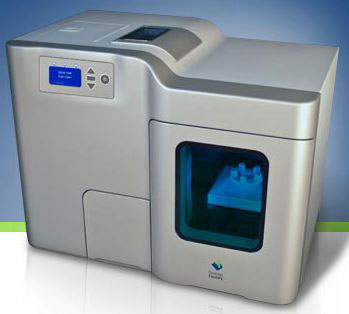The Radicalness Of 3d Printing
Way back in February of 2011, I wrote an extensive article for H+ on 3D printing and how it would allow a transition between an economy based on material “value†and scarcity to one based on nonmaterial “value†and abundance. Also, in a later article published here, I expanded on why this is inevitable and wrote, “it should be obvious that 3d printers allow for goods to behave as if they were nonmaterial. All you need is a single item and you can make an infinite number of copies.†Basically, once 3d printing is refined to a point in the not very distant future to where it can manufacture almost any arbitrary product, the value of that product will reside in the computer file, not the actual physical object.
So now, “The Motley Fool†is repeating my logic to sell investors on 3d printing: “If a physical object is a software code, then… there are no longer economies of scale in manufacturing.â€
In other words, it won’t make sense any more to pay Chinese factory workers to make 100 million duplicates of the same product. Better to pay American designers to make 10,000 different products specially tailored to individual customers — in the exact size and style they want to buy. Products they can receive in the mail, or print out at Home Depot, FedEx Office, Wal-Mart, or whichever retailers are smart enough to embrace this technology first.
If a physical object is a software code, then… everyone from an aerospace engineer to an ice sculptor is really a computer programmer creating digital designs. And the market for those designs will be just like today’s market for music, movies, and books. You’ll have the iTunes store, Amazon.com, and other legitimate download vendors on one side of the law, and a thousand fugitive “pirate bays†on the other.
Now, I would change the language of “legitimate download vendors†for “corporate gatekeepers trying to lock people into proprietary designs intended to prevent competition†and “pirate bays†with “the open source free marketâ€.. but you get the idea. Big Business is starting to realize, as predicted, the vast potential for profits that can be generated right up to the final stages, when home printers become as common as smartphones. As I stated previously:
“Look at this from the manufacturer’s side. The only cost they have incurred is the R&D cost of designing an item, and the cost of running a website. They don’t even have to concern themselves with obtaining the raw materials to make an item from, nor do they have to pay a staff to run the printers, pay the electric bills to run the printers, rent a building to house the printers, pay a transporter to haul the products to market, have a warehouse to store extra products. In fact, they will have put ALL of these issues off on the customer. All that they will have to be concerned about is designing a product, testing a few dozen prototypes to fix the rough edges, and viola, a market ready product at minimal cost that need only sell a few thousand copies to pay off design fees, at which point everything else is pure profit.
If I have faith in anything, it’s in corporate greed. Once it’s cheap and easy to put a 3D printer in every home, and eliminate every cost of manufacturing to the “manufacturer†by passing it on to the customer, major corporations will get it done in a heartbeat. And they won’t give a damn about the consequences, because the only concern will be the profit of the moment. CEOs will be all too happy about the billions they will save by making their companies cost nearly nothing to run, while still selling the same number of products at the same price they used too. It’s all too predictable.
But the fact will still remain that by doing so, those very same corporations will be destroying themselves. They will be counting on their brands to continue carrying the same weight they did in the industrial era, and they will assume that by eliminating costs, they will be able to keep on charging the same price while making almost pure profit. And they will be right, at first.â€
The Motley Fool is making the same case, telling individual investors that 3d printing is going to be a massive money maker, using the same logical points I made almost 2 years ago. And this will drive investment in further research and improvements in 3D printers. In fact, Makerbot just released its next generation printer.
But to be honest, there is still much work to be done before 3D printing on the scale that I’m talking about can occur. One of the much needed improvements is in the “resolution†of the finest details that can be printed. Fortunately, this is being worked on. The Vienna University of technology is working on printers able to work on the micrometer scale, which is a major needed step for printing electronics and biological tissue. When this hits industrial scale in about five to six years, we will probably have advanced the precision even further to the Nanoscale, though I would qualify that by saying that Nanoscale precision is likely to only be able to use specific materials, namely graphene and other single atom thick materials. True “nanofactories†able to use every element will take longer. However, even micrometer scale manufacturing is going to enable some very radical technological upheavals, as they will enable the first stages of bioprinting and electronics printing. This makes In-vitro food manufacturing and the kind of body modifications I discussed in my article on Gender Change well within the realm of feasibility, as well as the majority of the products I’ve discussed in the past such as QLed displays, Skin tight exoskeletons, film electronics, and active cloth.
And yet another field in which 3D printers need improving is the “ease of use†factor. This is also being addressed by software that can analyze the 3D model and apply engineering “artificial expertise†to modify the object in a manner that provides greater strength to the finished project. This is an example of a high level interface to a low level process. The end user doesn’t need to know engineering, because the software provides the engineering knowledge. This is one of the vital steps towards making 3D printing so easy to use that anyone can design a product that can compete in the open market. Another example is software that makes custom DNA design as simple as drag and drop. Once you can use 3d printers to “print DNAâ€, such software could enable radical technologies as custom designing your own DNA to, oh, say, change your “species†to succubus? Or create “mythological†animals such as griffins and unicorns?
Needless to say, as radical as those concepts might seem now, as time goes by, it’s going to start seeming more and more mainstream. As more and more people begin realizing the possibilities, and begin exploring them, it’s going to lead to even greater radicalness than this.


